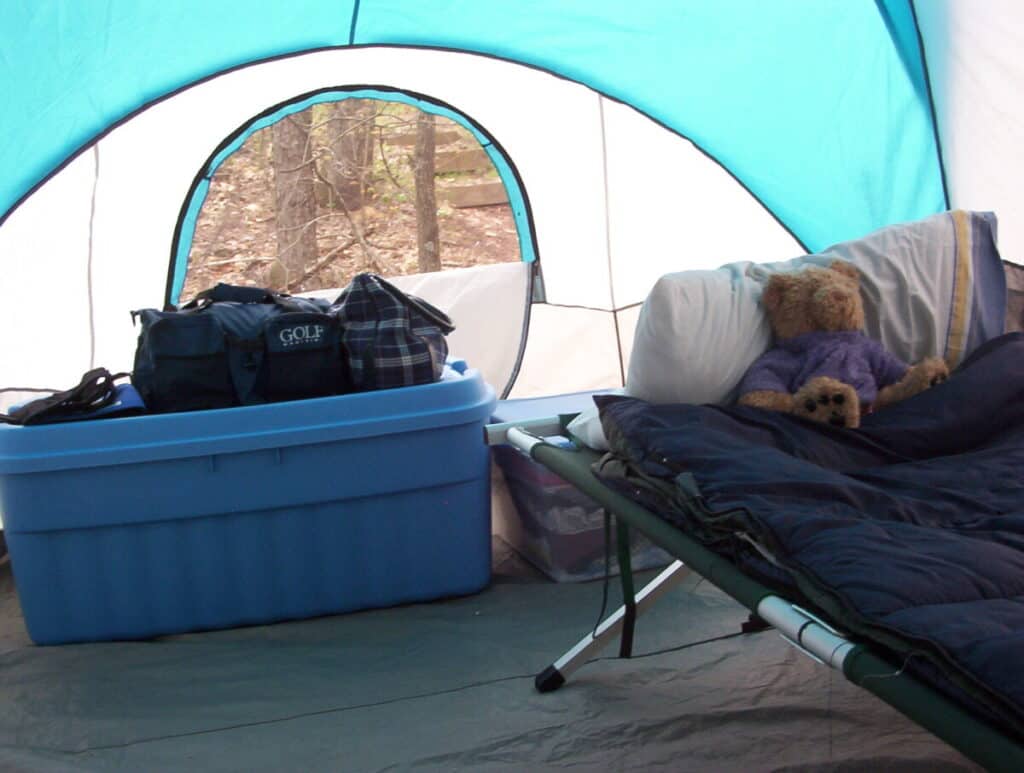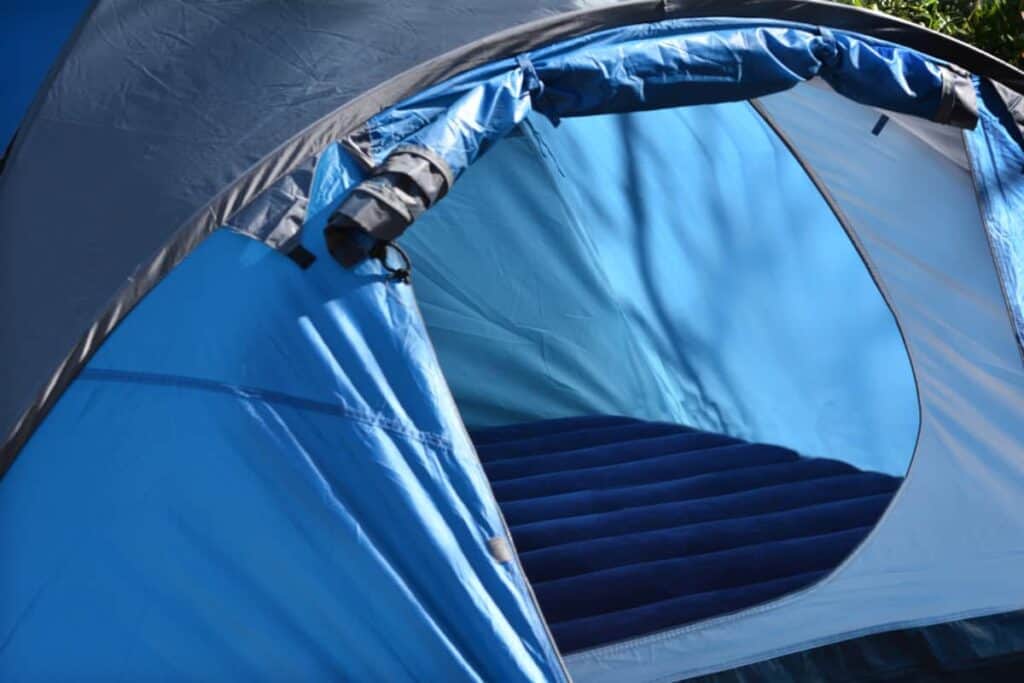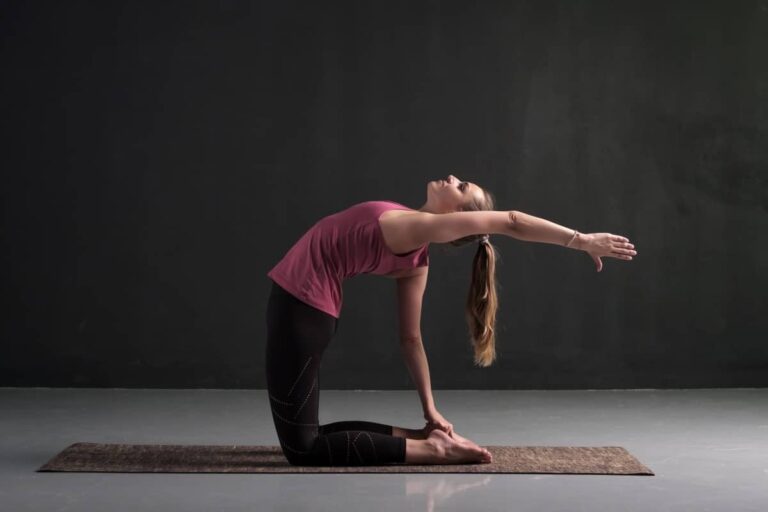Cot vs Air Mattress: Which is Best for Tent Campers
Choosing between a camping cot vs air mattress comes down to pure preference! But how do you know which is right for you? In all honesty, you won’t until you try them both! With that being said, we’ve put together a comprehensive comparison between the two in order to help you make a more informed buying decision.
Whether you are a seasoned camper or you are just about to go out for your first camping trip, investing in an air mattress or a camping cot can help give you a good night’s sleep, making your camping experience that much more enjoyable.

The Showdown: Cots vs. Air Mattresses:
Advantages of Camping Cots
- They come equipped with extra storage pockets to allow you to store important accessories such as hiking boots, flashlights, and other few personal items.
- Thanks to their rugged design, camping cots are designed to tackle nearly all types of weather conditions.
- Cots give you the benefit of enjoying your sleep higher above the ground–this can actually mean a lot for those where getting into and out of bed isn’t a small feat.
- Today’s camping cots are very strong, compact and lightweight.
- They offer a place to sit on and dress up. A tall air mattress can do the same, to be fair.
- Camping cots usually take up less floor space and can collapse into a small space as well.
- You don’t need a pump or anything else to sleep except your pad and blanket/sleeping bag.
- No electricity needed!
Disadvantages of Camping Cots
- Relatively More Expensive
- Cots can get cold if you don’t insulate the cot, yourself.
- Some cots can be heavy and bulky–others are designed for backpacking, but the biggest complaint is that they are more fragile.
- Camping cots can destroy your tent floor if you aren’t careful. (want to find out how to keep your floor safe from your camping cot? Check out our article, here)
Advantages of an Air Mattress
- Offer the much-needed bed-like comfort:
- They are extremely portable and easy to store.
- With an air mattress, you have complete control over how soft or firm you would want your sleeping surface to be.
- An air mattress is the most cost-effective option for car camping.
Disadvantages of Air Mattresses
- You must inflate them before use and this can be a daunting task. It also means that a pump is one extra accessory to tag along for your camping trip.
- They are prone to physical damage through punctures and tears. It’s kind of discouraging to wake up in a pool of deflated air mattress in the middle of the night.
- Air mattresses take up a lot of room in your tent.
- No matter the quality of the air mattress, they do lose air over time requiring you to pump it up (usually before you go to sleep every night)
- Cheaper plastic-made air mattresses are known to produce a squeaky noise anytime you move around and this is pretty annoying.
- If you don’t bring a sheet or blanket to put under you, a lot of people complain of getting very hot sleeping on an air mattress. If you’re camping in cold weather you won’t have this problem.
- If you need a pump to inflate your air mattress (and you almost always can inflate it without an electric pump), if you get in late, you’ll have to wake up everyone with the sound of an air compressor to inflate it.
Detailed Comparison: Camping Cot vs Air Mattress
Now that you have enough information regarding these two camping sleeping systems, let us delve much deeper into the cot vs air mattress discussion. In this section, we are going to carry out a detailed side-by-side comparison of the two based on many factors.
Ease of Setup and Handling
A camping cot should be very easy to set up and dismantle. Putting together your cot shouldn’t take more than 15 minutes at the most. But once you’re set-up, you don’t have to reinflate or worry about it until it’s time to pack up and go.
Camping cots featuring foldable designs are the easiest to set up. You only have to unfold the frames and secure them in place and you are ready to go. Sometimes the feet setup can be more involved, though.
Air mattresses aren’t hard to set up but you need to either bring a manual pump or an electric pump to inflate them. (if you want to learn how to inflate your air mattress without electricity, check out our article, here)
The huge disadvantage of this is that if in any case, you forgot to bring your air pump along, or you have damaged valves, you are likely to have a long night.
You have the option to purchase the self-inflating air mattresses equipped with an internal electric pump to automatically deflate and inflate the air mattress. However, one downside of these self-deflating mattresses is that their built-in pumps produce lots of noise–and… if the built-in pump breaks, well… you will have to get a manual pump to inflate it (see how to do that, here)
TL;DR: Camping cots and air mattresses are about equal in difficulty and hassle to setup. (although some cots can be a huge pain in the butt)
Sleeping Position
People sleep either on their stomach, back, or side. Regardless of your preferred sleeping position, your camping sleeping system should provide optimal support and comfort ideal for a good night’s sleep.
Globally, nearly 70% of adults sleep on their sides. For many, myself included, there is no better sleeping position than side sleeping. Whether you would like to fully extend your legs, revert to the famous fetal position, or keep one of your legs straight, curling up on one side is a comforting way to get enough rest.
If you are a side sleeper, your sleeping system should feature a surface with medium firmness. This will provide better conformity to your body shape without putting excess pressure on your hips and shoulders.
In this regard, you will likely go for an air mattress because it allows you to choose the level of firmness that can offer the desired comfort and support for a side sleeper.
In our camping cot vs air mattress argument, camping cots may not be great for side sleepers. This is primarily because the fabric used in camping cots results in a taut surface when you lie on it.
If we were to rank sleeping positions by popularity and health, lying on your stomach will likely feature at the bottom of the list. While it can be a great position for snoring or sleep apnea, the anticipated benefits don’t extend much further!
Sleeping on your back is not the most popular sleeping position, but it’s arguably the best position. By far the healthiest option, sleeping on your back allows your head, spine, and neck to rest in a neutral position. This implies that there is no excess pressure on these areas, so you are less likely to have pain.
I like sleeping on my back to relieve lower back pain, but when camping I usually roll over on my side.
In this regard, an air mattress with a memory foam top layer is highly recommended because the foam easily conforms to your body without compromising the level of comfort. You can read more about using mattress toppers while camping in our article, here.
If you are a back sleeper, you will need a relatively firm sleeping surface as well as a low-profile pillow for proper spine alignment. A camping cot is best suited for this role and this is a great sleeping system for back sleepers.
That being said, I’ve slept on an air mattress on my back without issue–so it will really depend on the firmness of the air mattress and your own body.
TL;DR: Cots are great for back sleepers, air mattresses are great for side sleepers, but you can make any sleeping position work with either of them.
Storage
You also need to take into account the amount of space your sleeping system will require when you store it at home between camping trips.
In terms of storage and transportation, air mattresses range from very compact to bulky. Our queen air mattress is very tall and it is likely 2ft by 8 inches when rolled up.
With an air mattress, you need to deflate it, fold it and place it in its storage bag (or just let it kick around without a bag like we do). And if you have an air mattress, with a built-in pump the process is even easier because the built-in electric pumps will help with the deflation.
Thanks to their increased thickness, air mattresses are known to occupy a lot of space when inflated in the tent. Their camping cot counterparts may take up just as much space but give themselves an edge by offering an under-the-bed storage space. What’s more, some camping cots come equipped with storage spaces that you can use to store your camping valuables.
It is also important to note that some camping cots feature robust but rigid frames that occupy lots of trunk space even when folded. These types of cots are not usable when hiking or backpacking. They are simply too bulky and heavy to lug around.
However, there are backpacking cots. If you want to see some examples of backpacking cots, check out our article, here.
Air mattresses are not really usable for backpacking or hiking. You can bring a large inflatable sleeping pad but that’s about as much as you can take. A standard air mattress is too bulky and heavy to be practical.
TL;DR: Cots and air mattresses can take up a lot or a little room depending on their size and quality.
Wrecking Your Tent Floor With a Camping Cot
The big problem with a camping cot is that if you choose to use them in your tent, you are putting all your body weight onto the cot which distributes that weight among its feet. Depending on how many feet the cot has, this can put a lot of pressure on the feet which can damage your tent floor.
To get around this, you have to be careful about getting on and off the cot so as to not rip the tent floor, but you can also put a covering under the cot or even opened tennis balls. If you want more ideas on how to protect your tent floor, make sure and check out our article, here.
Durability
When it comes to settling the camping vs air mattress debate, it’s important to ask: how long will a camping cot or air mattress last?
You want a sleeping system that does not only serve you for an extended period, but one which will equally remain structurally sound during use, transportation, and storage.
In this respect, camping cots are head and shoulders above their air mattress cousins. They are not only the sturdiest but the most durable as well. As we previously mentioned, they boast robust and durable aluminum frames covered with sturdy fabrics for enhanced strength and longevity.
That being said, if you get a backpacking cot, many people complain that these cots are prone to breaking from extended use. You have to be very careful with these lightweight cots–if you jump on one, the aluminum frames can bend and ruin your cot.
You also have the option to purchase one featuring a steel frame that guarantees extra durability and sturdiness.
An air mattress is comparatively less durable and can leak from punctures from sticks and other sharp objects. What’s more, they are prone to losing air during the night. If you want to take your air mattress camping, you might want to go for an air mattress with a thicker PVC layer as this can help keep general air leakages, seam splits, and occasional tears at bay.
Some air mattress models use a built-in coil system that not only helps stabilize the mattress, but enhances lumbar support, and prevents unnecessary sagging. This feature may also extend the lifespan of your airbed.
TL;DR: A standard cot will be more durable than a standard air mattress–but backpacking cots are more fragile.
Size Does Matter
While this is solely a personal preference factor, if you’re planning on sleeping with someone then this is important to consider.
If you will be going camping as a family or a group, then an air mattress might be your best bet for having a good night’s sleep. Simply put, they are designed for a shared sleeping system. They are available in a broad range of sizes, including twin, queen, and king sizes.
Though there are double camping cots on the market, cots are mainly designed to serve one individual. But, if the space of your tent is large enough, there are relatively bigger cots that can accommodate a few people–but be prepared to spend a lot more money for these.
TL;DR: It’s more cost-effective to sleep with an air mattress when co-sleeping with someone else.
Elevation off the Ground
One of the favorite parts of camping cots is that it’s elevated off the ground. There are all sorts of reasons why this is nice. Rather than getting up off of the ground, you are getting up out of a makeshift bed, which makes it easier to get up and get down (for those who are older or stiffer).
Air mattresses can be pretty tall, though–but sitting on an air mattress causes it to dip where you are sitting making it tough to get up from.
Staying Warm: Cots Vs. Air Mattresses:
Cots:
When talking about air mattresses or cots, both need help to keep you warm in cold weather.
Sleeping on a cot can lead to a very cold sleep if you don’t put insulation underneath your body. Having open air underneath the cot can lead to a mini bridge effect (notice how some bridges ice over while the rest of the road is warmer?).
Make sure to put a sleeping pad with a decent R-value on your cot.
If you want to minimize the bridge effect, you can put a blanket on the sides of the cot and let the blanket hang to the floor to prevent airflow underneath your cot.
Air Mattresses
Air mattresses don’t have the same bridge effect but the air inside the air mattress can get cold. So it’s also important to put insulation on top of the air mattress (and under you) to keep you warm.
We’ve had luck with an eggshell mattress topper on top of the camp bed and that will work well on top of an air mattress.
Staying Cool: Cots Vs. Air Mattresses
Cots:
Cots win in this regard–they have airflow underneath the cot which can help cool you off in hot weather. Go cots!
Air Mattresses
Air mattresses need at least a sheet or other thin blanket between you and the plastic. Sleeping with your bare skin against the plastic feels somewhat stifling and can get hot and uncomfortable.
Other Features Worth Noting
Research has proven that airbeds offer some sort of relief from back pain. After all, you can easily adjust their level of firmness to accommodate a range of body sizes, weights, sleeping positions as well as body shapes.
Airbeds made from materials that don’t feature VOC compounds reduce allergy risks.
Most airbeds have plastic materials that not only tend to slide around with even the slightest body movement but also produce lots of annoying sounds.
Camping cots, on the other hand, are relatively more stable hence doesn’t allow for any movement.
Camping cots, thanks to their construction design, allow you to sit on and dress upon them with minimal fuss.
Camping cots come equipped with pockets that you can use for storage purposes.
Some camping cots are highly versatile enough to convert themselves into benches for additional applications.
What Are Camping Cots

A camping cot is simply a type of collapsible camping bed typically designed to enhance your overall comfort. Also known as a camping bed, camping cots usually look strikingly similar to the US army gurney. Of course, they are intended to be used when regular beds are either not suitable or available. And this implies that they are mainly used during emergencies, leisure outdoor camping, and army camps.
A great camping cot should be compact, highly lightweight for easy portability, and of course, reasonably comfortable so that you may start your day feeling rested and free from pain. A camping cot will always feature a foldable metal, or wooden frame with polyester, nylon, canvas, or linen covering for comfort.
A good number of camping cots are constructed from an aluminum frame with fabric stretching across the frame that becomes taut once assembled. And you are going for a prolonged camping escapade, you may want to carry along a foam mattress as well as camping pillow for optimal comfort.
When it comes to choosing the best camping cot, look for one that features a fabric that is highly comfortable and easy to wash. In this regard, both nylon and polyester get the nod. On the other hand, the canvas is more durable though it’s extremely difficult to clean.
As we previously mentioned, most cots feature aluminum frames done in either X or U-shaped designs. This is because aluminum is not only rust-resistant but equally easily foldable, durable and somewhat lightweight.
What Are Air Mattresses

Also referred to as a blow-up bed or airbed, an air mattress is simply an inflatable mattress made of PVC (Polyvinyl chloride) or textile-reinforced urethane rubber or plastic. When in deflated form, air mattresses can be compacted, stored or carried in a small form.
They have become popular among backpackers, campers as well as homeowners thanks to their affordability and a broad range of applications.
An air mattress can be used for camping, temporary or full-time home applications, and can also be optimized to accommodate several uses, for example, guest and camping use.
A portable air compressor or a hand-held pump is usually used to inflate the airbeds for use. It is also imperative to note that others are automatically inflated when the valve is opened, up to a certain pressure but additional inflation may be needed either manually or by a pump.
Conclusion
For camping enthusiasts, you already know how essential it is to have a good night’s rest. And this is why it is highly advisable to equip yourself with a high-quality sleeping system. In the camping sleeping system arena, the battle is mostly between the camping cot vs air mattress.
As experts in the industry, we have provided you with a comprehensive comparison article between these two valuable camping essentials. While the choice of the best sleeping system is always down to individual preference, you would agree with me that camping cots have a bit of an edge over their air mattress counterparts.





